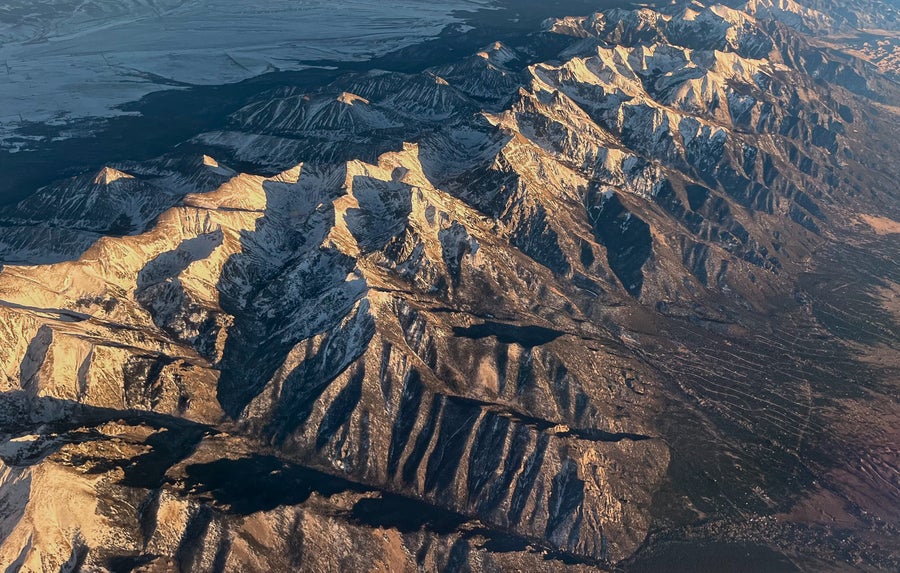December 23, 2024
3 min read
How Climate Change Could Trigger Earthquakes
Climate change may influence seismic activity as melting glaciers reduce pressure on quake-prone faults

North Crestone Creek valley, a U-shaped valley carved by ancient glaciers in Colorado.
Southern Colorado’s Sangre De Cristo Mountains jut up abruptly from the flat expanse of the San Luis Valley. The mountains’ namesake fault system sculpted this imposing geographical transition over millions of years and occasionally rattles the area today. A new study suggests that the melting of alpine glaciers thousands of years ago may also have increased this area’s quake frequency by relieving pressure on the fault.
We don’t typically associate the climate of Earth’s atmosphere and surface with plate movements miles deep in our planet’s inscrutable bulk. But the new study, published in Geology, offers rare evidence of how warming temperatures—like those occurring today—may actually trigger fault activity. As temperatures continue to rise, researchers caution that other glaciated and quake-prone regions could face similar risks. “Areas where glaciers are retreating, or changes in the hydrologic cycle are happening over active faults, might experience elevated earthquake activity,” says study co-author Sean Gallen, a Colorado State University geologist.
Around 25 million to 28 million years ago, North America’s western interior began to split, creating the Rio Grande Rift. As the land slowly unzipped, the San Luis Basin sank while the Sangre de Cristo range arched skyward, with a vertical shift of up to 9.2 kilometers between the two sides. Then, beginning about 2.6 million years ago, global temperatures plummeted, and the Sangre de Cristos’ peaks filled with glacial ice. Glaciation culminated in the Last Glacial Maximum around 20,000 years ago, carving dramatic U-shaped valleys and depositing moraines—rubble piles marking the ice’s farthest extent.
On supporting science journalism
If you’re enjoying this article, consider supporting our award-winning journalism by subscribing. By purchasing a subscription you are helping to ensure the future of impactful stories about the discoveries and ideas shaping our world today.

Western side of the Sangre de Cristo Mountains, Colorado.
Adding or subtracting surface mass can alter the stresses upon Earth’s crust. For example, when mountains rise, the crust bends beneath their weight, like a diving board when someone stands on it. As the mountains wear and crumble over unfathomable time, the earth rises again. This process, called isostatic rebound, can cause minor seismic activity. That’s why relatively ancient ranges such as the Appalachians still rumble from time to time.
Gallen and his co-author Cecilia Hurtado, also of Colorado State University, wondered if removing glacial mass could similarly influence seismic activity. They hypothesized that melting glaciers might alter the stresses on faults, potentially accelerating earthquakes in the short term by reducing the load on the crust.
Computers can model this behavior fairly easily, but testing the concepts in nature is the gold standard, Gallen says. There are few locations where concrete evidence is preserved, however: in one example, Wyoming’s Teton Fault saw more seismic activity as the Yellowstone Ice Cap melted. The new study reveals how this phenomenon may be more common than scientists thought, says Jessica Thompson Jobe, a U.S. Geological Survey geologist, who was not involved in the research. “It’s pretty unique,” Jobe says of the study. “They’re trying to link climate with fault activity, and this is a great place to do so because you have information for both datasets. That isn’t always the case.”
To support their hypothesis, Hurtado and Gallen built computer models based on the Sangre De Cristo landscape’s raw features, such as moraines, as well as fault scarps resembling splits in the Earth’s skin, that provide clues about the timing and location of prehistoric earthquakes. The researchers used high-resolution lidar (light detection and ranging) and satellite imagery to map these features. Finally, the team compared these models with real-world evidence, proposing that Ice Age glaciers “clamped” the fault system and suppressed earthquakes. As glaciers began melting less than 20,000 years ago, the weight lifted and released pent-up stress. This triggered a dramatic fivefold increase in earthquake frequency, a phase of heightened seismicity compared with pre–Glacial Maximum levels, that likely persisted until the glaciers finally receded.

The Sangre de Cristo fault scarp (denoted by the black arrow). The blue lines show the approximate termini of glaciers from the last ice age.
Eric Leonard, a geologist emeritus at Colorado College, who was not involved in the research, agrees that the melting of even the Sangre de Cristos’ relatively small glaciers could have significantly impacted fault activity. He adds, though, that the ages of the faulted surfaces are uncertain, which affects the accuracy of the earthquake timing. Gallen acknowledged that more precise—and expensive—methods for dating the faulted surfaces could improve the earthquake timeline. But he and Hurtado are confident that these findings reinforce earlier research from the American West. “What we have here is compelling evidence,” Gallen says.
The study authors also caution that regions with active faults and large ice or water loads—now shrinking as global temperatures rise—may face more earthquakes in the future.
Leonard added that just a three-degree Celsius (5.4-degree Fahrenheit) rise in temperature melted most of the ice in the Sangre de Cristos, which raises concerns about larger ice masses today in tectonically active areas such as the Himalayas, the Andes and Alaska. “Will this significantly add to hazards?” he muses. “I don’t know, but it certainly has potential.”

